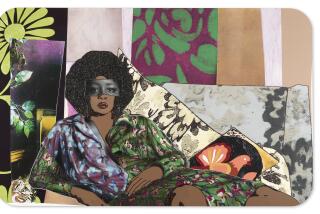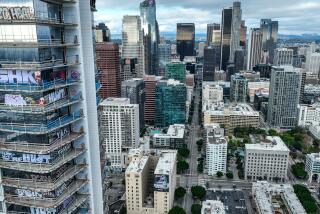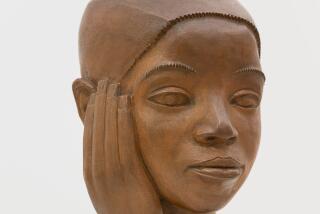Robin Rhode keeps chalking ‘em up
On opening night of Robin Rhode’s exhibition at the Los Angeles County Museum of Art earlier this month, a crowd stood facing a blank wall just inside the entrance to the Ahmanson Building. Museum workers had coated the wall in black chalkboard paint, according to the artist’s specifications; Rhode was bringing his own chalk.
Late into the designated hour, without fanfare, Rhode pushed through the wine-sipping minglers, grabbed hold of the wall’s edge and pulled, straining as if to move it. With a thick stick of chalk, he drew a wavy line, about waist-high, and made as if to pull that, like a rope. With frustrated urgency, he plucked a man out of the audience and motioned for him to join the effort. Then a museum guard. “Come on, let’s do this!” Rhode pumped up his team, as it grew to six.
The rope thickened as the artist drew more strands, while white streaks dusted Rhode’s dark sweat clothes. Suddenly, Rhode directed the group to reverse direction, and they started to pull, just as hard, the opposite way. Rhode, now in the rear instead of at the head, continued to tug mightily, backing his way to the edge of the wall and beyond, disappearing into the crowd as unceremoniously as he had come.
The performance lasted just a few minutes, charging the room with raw energy. The works in Rhode’s Contemporary Projects show on the other side of the wall were generated in a similar spirit: part space-claiming street action, part theater, part visual event. The video animations and photographic sequences on view toy with illusion, merging two- and three-dimensional worlds. Some also gnaw at issues of racial division and inequity.
Rhode (pronounced road-uh) was born in Cape Town, South Africa, and moved to Johannesburg when he was 7. According to the country’s racial classifications, he is colored. The complexities of that status course through his work, but not always in obvious ways.
“Race is not the first idea, the first concept that’s on the table,” he says. “The first concept is always drawing.”
In conversation on his 34th birthday, Rhode traced his approach back to its origin in a high school initiation ritual. He has told the story so many times in the last 10 years, as his international acclaim has risen and spread, he agrees with a laugh that it sounds like a creation myth. But it is true: When he was a student, the older kids at his school would draw shapes in chalk on the bathroom walls and force underclassmen to engage with them. They’d draw a bicycle, for instance, and make the younger kids try to mount it. They’d draw a candle, and require it to be blown out.
“It was about impossibility, about failure,” says Rhode, affable, articulate and boyish, his thin mustache looking like it could be his first. “At the same time, it was about belief. Through your physical interaction with that drawing, you believed that it was actually real.”
The ritual made a lasting impression, not just its formal aspects but its implications, in using stolen chalk to visualize a means of mobility and freedom that he and his classmates lacked. “Only when I was at [art school] could I revisit this initiation process and ask what it represents to me. That moment is epic. It’s emotional, it’s social, it’s political.”
Rhode was in college in Johannesburg when he went to an art museum for the first time. After receiving his diploma, he floundered briefly before earning a scholarship to film school, where he studied production design and learned to construct a narrative through storyboarding.
He left the film program after one year to devote himself more fully to his work. By this time, he was already participating in group exhibitions and doing impromptu performances. He drew a park bench on the side of Cape Town’s Parliament building and loitered around it. He drew a urinal on the South African National Gallery, then used it. He started photographing the events and constructing sequences of images that read like the frames of stop-action animations or the pages of a flip book.
Sometimes he drew on the pavement and photographed from above, so the ground reads as a wall: a figure curled on the street appears poised to make a slam dunk into a chalked net; another lying on his side seems to be skating the skinny, smiling line of a half pipe.
The bicycle shows up again and again in his work, “an emblem of economy,” he says, separating the haves and have-nots. In the LACMA show, which offers a small sampling of recent work, Rhode pairs a full-size bike encased in minty green bar soap with a bucket of water, the instrument of potential dissolution.
In the five-minute animation “Promenade,” spray-painted white diamonds proliferate on a gray wall while the artist, in a dark suit and stocking-mask, responds balletically to the canopy of shapes.
Rhode has lived in Berlin since 2002 with his wife, also an artist, and their young son. He acts in his own pieces but also uses others to serve as “a kind of shadow self.” This allows him greater control of the directorial process and the photography, and reinforces his notion that the individual featured should be as unidentifiable as the setting he operates within.
“I move in and out of this character,” Rhode says. “That’s why the doppelgänger always has a mask or a kind of shadowed, blacked-out face.”
Rhode has exhibited widely and already been the subject of three career surveys (in Munich, London and at the Wexner Center for the Arts in Columbus, Ohio), but this is the first time his work has appeared in L.A.
“It really speaks to the urban context,” says Leslie Jones, the prints and drawings curator who organized the show. “There’s the whole history of street art in L.A., as well as the strong history of performance art. Also, I thought to put his work in an encyclopedic museum would be interesting, because it speaks to the range of drawing practice, from a primal form of expression -- drawing on walls to bring something into being -- to drawing in its most refined form, perspectival drawing, dealing with opticality.”
Rhode feels particular resonance with cave painting. The starting point of humankind’s expression is not only on the caves of Lascaux in France, he points out, but on the cave walls of Southern Africa, which were painted by Bushmen.
“The Bushmen were light-skinned as well and didn’t have a massive physical stature, so the colored people, we would always refer to ourselves as Bushmen, in a subversive but playful way. The Bushmen [drew] on the caves. We did it on boys’ toilets. And I’m going to do it on museum walls and public walls.”
More to Read
The biggest entertainment stories
Get our big stories about Hollywood, film, television, music, arts, culture and more right in your inbox as soon as they publish.
You may occasionally receive promotional content from the Los Angeles Times.










